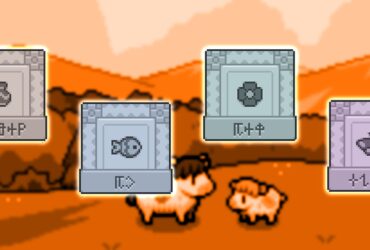Most survival games have one particular mechanic that ends up taking quite a bit more time and effort than the others: building. Squirreled Away is no different in this regard, allowing you to build tree houses for your squirrel to enjoy in their downtime, or when crafting more advanced objects.
While the basics of building are pretty straightforward, it will take a little bit to unlock everything you’d like to have to perfect your tiny home, as well as some ingenuity when it comes to putting it all together. From the basics to the more advanced components, we’ve got you covered.
How To Build A House
You won’t be able to build anything until you’ve passed the tutorial island called Sunrise Isle. Once you’ve finished the tutorial and you’re on The Forest Nook, you’ll have access to a Home Tree.
This Home Tree acts as the first location that you can build in, though there are more locations that you can unlock, which we’ll get into later.
When you’re in your Home Tree, you can the button that prompts on the bottom right of your screen with the wooden hammer, to enter build mode. In build mode, you’ll have access to a few different menus:
- Floors and Walls
- Roofs and Beams
- Doors and Windows
- Decorations
- Utility
- Chests
You’ll be using all of these at some point, and you’ll unlock more recipes constantly as you progress through the game.
Unlocking new recipes usually requires meditating on items at a Squirrel Sanctuary. To tell if your item can be meditated on, go to your inventory and hover over it.
Building Necessities
There are very few building necessities in Squirreled Away, meaning you can largely do anything you want with your home. But there are a couple of things that you’ll need to have for certain utility items to work:
- You’ll need a floor, which is pretty standard for having anything in your home whatsoever.
- Certain items, like a bed, also require a roof. This does not mean that you need a roof over your entire home, but it does mean that you’ll need a roof over those particular items.
Keep in mind that you cannot edit or move items once they’re placed. But you can demolish them, and doing so will give you all of the resources that it took to build them back.
Where To Gather Materials
Almost every single foundational recipe for building requires wood. Depending on what you decide to build out of and how fancy you make your home, you might need smaller quantities of other items too; we’ll list every basic building material here, and a good way to get them.
|
Item |
How To Obtain |
|---|---|
|
Stick |
Sticks are the easiest wood material to gather large quantities of; there are plenty of sticks on the upper levels of trees that you can harvest with a low-level axe. Once you’ve got the Scrap Axe, you can harvest the larger branches that are lying on the ground, gaining you more sticks at a time. |
|
Planks |
Planks are made from sticks at a 2:1 sticks-to-planks ratio. These are crafted at a Saw Station, which you can craft for six sticks and four rocks. |
|
Rocks |
These are found in every region on the ground. Oftentimes these are grouped together, and near bigger rocks. With an upgraded pickaxe, you’ll be able to break the bigger rocks, giving you more rocks at a time. |
|
Glass |
Glass is gained from breaking glass bottles. The easiest place to do this is near the restaurant in Greenleaf Shade; there will be two bottles lying on the tables underneath the umbrellas. But, there are more bottles scattered occasionally in other areas, too. |
|
Can Scraps |
These are gained from breaking metal cans. These are also found in multiple places, but Greenleaf Shade and Fountain Springs have the largest collection of them. |
Most resources respawn after just a few minutes or after leaving the area and coming back. This makes it fairly easy to make a path through the map, constantly collecting materials, allowing you to get quite a lot in a short amount of time.
Every Location You Can Build
There are a few different locations that you can build in. Some of these locations are given to you for free or as a reward for a quest, while others you’ll need to buy with materials.
All of these can be found in Squirrel vision, either at Home Tree, a tree with a money symbol, or as a quest marker, in the case of Howard and, eventually, Howard’s Palace.
|
Region |
Description |
Cost |
|---|---|---|
|
The Forest Nook |
|
|
|
Fountain Springs |
|
|
|
Greenleaf Shade |
|
|
|
The Ascended Gardens |
Completing the quest for Howard the Delicate will award you a tree called Howard’s Palace, which you can do anything that you’d like with, once his quest is complete. |
|
Tips For Building
Building can be a little bit finicky, and getting things to go exactly where you’d like them to go can be tough. There are also quite a few things that you can accomplish building in this game that you can’t in others, simply due to the fact that you’re building a house for a squirrel, and not a human.
Climb To Build
Sometimes, clinging to the outside of a wall or on a nearby branch can help you to get a better angle on where you’re trying to place something. Take advantage of your squirrel’s ability to defy gravity to get the angle that you need to do what you want.
Sometimes, there won’t be something present to climb on. In this case, you can build a temporary platform that extends wherever you need it to go and build from there. You can demolish the platform when you’re done and regain all of the materials.
Low Ceilings
Your squirrel does not need much clearance, and you can take advantage of this in certain spots of your house. Your squirrel can crawl through very tight gaps, giving you an almost third-person view. This allows you to make hallways or rooms that aren’t possible in other games that feature human characters, and this should be taken advantage of here.
Walls Can Be Floors
For that matter, your squirrel can walk on a wall just as easily as it can a floor. That means you don’t need to build stairs or rooms with traditional transitions. You can have a wall that you walk up, or even combine a staircase into a wall, and then back into a staircase and to the ceiling, to make the ceiling another floor.














Leave a Reply